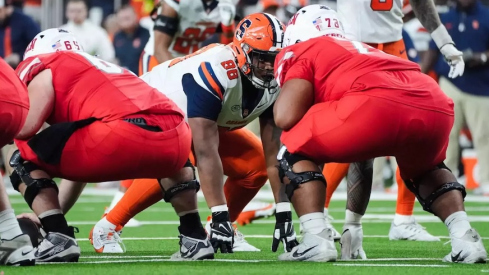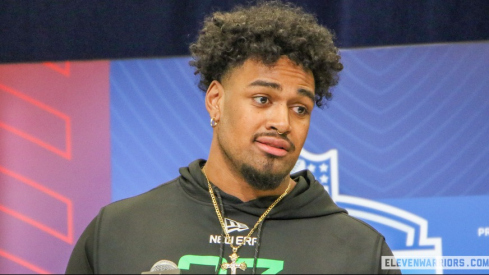This guest post was written by Ross Fulton, formerly of Buckeye Football Analysis and now with Scout and new Buckeye blog Along the Olentangy. Grab a pen and paper because he brings the football science, looking at the Buckeye 3-4 that you'll likely be seeing more of this season.
It is no secret that spread offenses -- those that employ 3 or 4 Wide Receivers and often line up in the shotgun with the threat of the quarterback as a runner--have proliferated in college football. What has received less attention is the innovative steps that defenses have recently taken to slow the spread down. Ohio State fans need look no further than the Ohio State defense to see a perfect example. Ohio State has adapted a 3-4 'half eagle; half under' look that works seamlessly with both Ohio State's nickel and traditional 4-3 under fronts to create a spectrum of potential fronts to combat the wide variety of offenses Ohio State will see. Ohio State's defense is leading the way in combating the spread offense that now proliferate in the college game, reflecting why it is annually one of the nation's best defenses.

A Quick Note on Techniques... To fully understand what Ohio State's defense is doing, it is helpful to have an understanding of defensive gaps and defensive techniques. To the right is a basic look at gaps and techniques (via MGoBlog). The letters correspond to the gaps the defense is responsible for. Ohio State is a '1' gap defense, meaning that each defensive player will be responsible for a single gap. The numbers then correspond to the techniques that a defensive linemen plays. Even numbers mean the defensive linemen is head up on the corresponding offensive linemen. So a '0' technique is a nose guard that is straight up on the center. An odd technique is then shaded over into the gap. A '1' technique is a nose guard that is in the gap between the center and guard. A '4i" technique, as you might expect, is in between the two. There, the defensive linemen essentially lines up on the offensive tackle's inside leg, splitting the defensive linemen's body with that leg. That is why it is said he lines up on the offensive tackle's 'eye.' Now, lets turn to how techniques fit into defensive schemes.
The 4-3 Under

Before examining Ohio State's 3-4, it is helpful to understand Ohio State's base defense. Under Jim Heacock, OSU has primarily been a 4-3 under team. This defense, long favored by Monte Kiffin and Pete Carroll, has a couple of core features. The basic idea of the front is that the strongside linebacker rotates down and actually aligns on the line of scrimmage, just outside the tight end. In respect, the defensive linemen shift to the strong side, such that one of the defensive tackles actually lines up as a nose guard over the center, though slightly shaded over. This defense is a mix between the traditional 4-3 and 3-4. In other words, the defense features a five-man front, with the 'SAM' linebacker generally head up over the tight end, and the Rush End (or in OSU nomenclature the 'LEO') just outside the weak-side offensive tackle. As this suggests, a 4-3 under team 'flips' their front to match the formation. Here is how Pete Carroll describes it:
In general we flip flop our defense. The SLB always goes to the tight end side. We often employ a rush and drop end from either side of the line. The rush guy goes with the SLB and the drop end goes with the WLB. The MLB aligns then to the SLB side of the play.
The result is that the defensive linemen play specific techniques and also flip. The strongside DE plays a '5' technique and travels with the SLB. The NG plays a 1 technique to the strongside, and then the backside defensive tackle plays a '3' technique to the weakside. These entire front therefore flips based on the formation strength.
The Ohio State 3-4
While continuing to play the 4-3 under, Ohio State has begun employing a second defensive front, a 3-4. Ironically, this was first generally commented on by USC's Offensive Line Coach Pat Ruel, who observed:
"Half their line was playing a 'bear' front and half was playing an 'under' front and they were stopping our outside zone running plays."
To break this down, Ruel was essentially stating that to one side of the center, OSU was in their under front above, but to the other side, they were playing a bear or 'eagle' front, which features the defensive front 'covering up' the offensive center and both guards. What did this mean in practice for what Ohio State was doing? Here are two good shots of the defensive front from different angles:

As you can see, Ohio State is in a 3-4. To the offensive formation's weakside through the nose guard, Ohio State defense is playing an under defense.
- Backside OLB: 5 technique
- Backside tackle: 3 technique
- Nose Guard: 1 technique
- Weak Inside (Will) LB: Backside A-gap
But to the formation's strength, Ohio State played an eagle look:
- Frontside tackle: 41 technique
- Frontside OLB: 7 technique
- Frontside Inside (Mike) LB: Stack on 3 technique
This establishes the basics behind the defense. The question becomes what does Ohio State gain from going to this front? Several reasons exist. First, the defense provides an effective check on 'spread' offenses. Monte Kiffin employed a similar front for Tennessee against Florida last year to great effect. From the aforementioned Smart Football article discussing Monte Kiffin's plan for Urban Meyer's offense:
Why do this? It’s a move Pete Carroll uses a lot at USC, but is particularly effective against a spread set without a tight-end. It’s a numbers issue: the defense “covers” every person on the offensive line (the five line guys, or three down linemen and two stand-up guys), while both possible ballcarriers — the running back and quarterback — have defensive counterparts, i.e. the two inside linebackers.
And it's not just about the x's and o's, but the Jimmy and Joes. By locking up the offense's interior line, it leaves the four more athletic linebackers in space to handle the ever-present zone read, rather than leaving a defensive linemen responsible for a quarterback keep. Second, this is effectively Ohio State's base nickel defense without inserting the nickel back. This is one reason why OSU flips the linebackers in the 3-4--because in the nickel the 'Star' generally plays on the formation's weakside. OSU simply has to substitute out the SAM for the Star and they can move interchangeably between the two defenses. As one can see in both, the LEO is playing to the same side as Heyward, the SSDE. The OSU 3-4 is a "halfway house" between the base 4-3 under and nickel. And this makes sense because the nickel is also designed to counteract spread offenses. The 3-4 is a way for OSU to get into their nickel package to counter spread offenses but keep an extra run stopping linebacker on the field. Finally, the 4-3 under and 3-4 looks are also fairly interchangeable. The defensive linemen are generally playing the same techniques in both looks. The LEO remains a 'hybrid' stand up end in both looks. Indeed, one cannot tell what defense OSU is in simply by looking at the LEO. He may be standing up but the defense is otherwise in its 4-3 under. Only by looking at the remaining defensive linemen can the defense be discerned. In sum, by going to the 3-4 Ohio State has created a 'spectrum' of three different defenses that are easily interchangeable from the defense's perspective, but also provide OSU the flexibility that they can combat both power-run teams, spread teams, and everything in-between. The OSU 3-4 will be one reason why the OSU defense remains one of the country's best.

